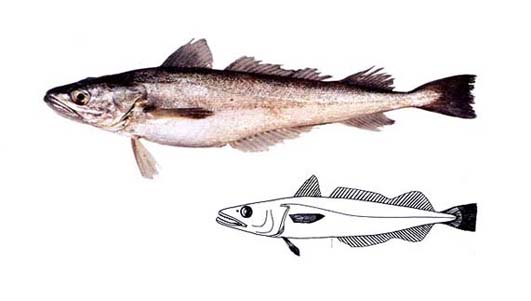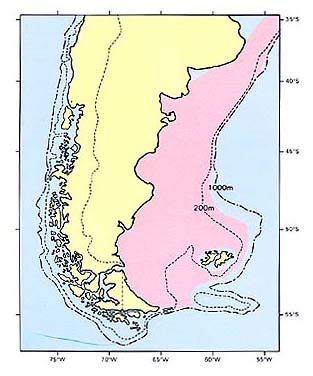メルルーサ科
- HOME
- デジタル図鑑
- パタゴニア海域の重要水族
- 硬骨魚綱 タラ目
- メルルーサ科
メルルーサ科(Merlucciidae)

External feature
34 アルゼンチンヘイク(Aruzenchin-heiku)
Merluccius hubbsi Marini, 1933
Merluza (Spanish speaking countries); Argentine hake (English speaking countries)
特 徴:
第1背鰭1棘,9~12軟条,第2背鰭34~40軟条,臀鰭36~41軟条,胸鰭13~16軟条,腹鰭7軟条,鰓条骨数7,縦列鱗数120~142,鰓耙数2~5+9~12=12~16,脊椎骨数23~26+25~28=50~53,肋骨数3~4。体長に対する頭長の割合は24.4~28.0%。頭長に対する吻長の割合は31.0~35.1%,眼径は15.5~20.7%,両眼間隔は24.0~28.2%,上顎長は47.3~52.2%。本種は他のメルルーサ類にくらべ頭部と眼の大きさは比較的小さく,鱗は大きい。胸鰭の長さは短く,体長40cm以上の個体では,その先端は臀鰭起部上に達しない。吻および口裂は短い。尾鰭後端は通常,截型であるが,小型個体ではやや突出するものがある。体は一様に銀白色。分布域が重複するニュージーランドヘイクとは鱗の大きさ,総鰓耙数,総脊椎骨数および体型で容易に区別ができる。
分 布:
南米の南東岸に分布する。分布の中心はウルガイ南部からアルゼンチン北部。分布の北限はブラジル南部の南緯28~30度付近,南限はパタゴニア南部のフエゴ島(南緯54度)まで。しかし,バードウッドバンクには分布しない。チリ南部からの記録はない。生息水深は50m~500mであるが,主として大陸棚上(Inada, 1981b)。
備 考:
春から夏にかけ南下して,沿岸域で産卵し,秋から冬にかけ北上して,沖合域へ回遊する(Hart, 1947)。一般に夜間に餌を追って浮上するが,昼間でもカタクチイワシを追って浮上することがある(Wrzesinka, 1975)。9歳で雄は56cm,雌は69cmとなる(Otero, 1977)。最大体長は95cm(Zinkevich and Sauskan, 1968)。若魚はアミ,端脚類を,成魚は魚類,イカなどを食べる。時折,とも食い現象がみられる。潜在資源量は大きく,400~690万トンともいわれている(JAMARC, 1979c)。漁獲量は近年多く,1978年で約42万トン。
(稲田伊史)
Material examined:
34 from Argentina (163.0-550.0 mm SL, 40-221 m depth), catalogue numbers: see Inada (1981b).
Description:
D Ⅰ, 9-12, 34-40; A 36-41; P1 13-16; P2 7; ORS 120-142; GR 2-5+9-12=12-16; ? 23-26+25-28=50-53; Ribs 3-4.
HL 24.4-28.0 % of SL; ED 15.5-20.7; SN 31.0-35.1; IO 24.0-28.2; UJ 47.3-52.2; P.L 15.1-21.2; P2L 11.3-16.1; PreD 28.1-31.1.
General appearance having rather short head and pectoral fin, medium sized snout, eye and gape, and large scales. Distal margin of caudal fin usually truncate, but that of smaller fish sometimes convex. Color of body silvery white.
Distribution:
Argentine hake is distributed along the east coast of the southern part of South America from about 28°S-30°S off southern Brazil to around 54°S, near the Falkland Islands. The center of abundance is in the Bonaelensis area. It mainly inhabits the continental shelf in depths between 50 m and 500 m (mainly around 200 m), at temperatures between 3.8 ℃ and 6.5 ℃ and at chlorinities between 18.4 ‰ and 18.9 ‰. It overlaps the Patagonian population of New Zealand hake (M. australis) between 49°S and 54°S.
Remarks:
This species has been confused with M. gayi and M. bilinearis by many authors, but is distinguished from M. australis in the shape of body, size of scales, number of gill-rakers and vertebrae (Marini, 1933). The tip of the pectoral fin of this species in specimens under 300-400 mm SL reaches or extends beyond the level of the anal fin origin, whereas in fish over 400 mm SL it does not reach there, although the relative length of the pectoral fin of this species is usually shorter than those of the other merlucciids.
(Tadashi INADA)

Distribution of Merluccius hubbsi in Patagonia.